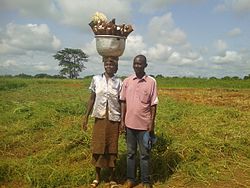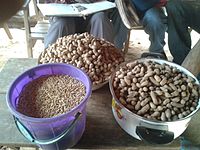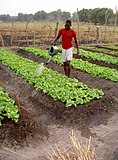Cuisine of the Central African Republic
| Part of Culture of the Central African Republic |
 |
|
People |
|---|
| Languages |
| Cuisine |
| Religion |
| Music |
|
Sport |


Central African cuisine includes the
Meat can be scarce in the Central African Republic, although
Roadside stalls sell foods such as baked goods and makara (a type of fried bread), sandwiches, barbecued meat and snacks.[4] In the forests and in markets of Bangui where forest items are sold, caterpillars and the koko leaf are eaten.[4] Restaurants are mostly for expatriates.[4] Wild tubers, leaves, and mushrooms are used.[4] Palm oil is widely used in various dishes.[4]
The capital city of Bangui has western foods and hotel restaurants.[5] The legal drinking age is 18. Muslims are prohibited from drinking alcohol.[5] The PK5 area is known for its smaller restaurants serving reasonably priced traditional dishes.[5]
Common foods and dishes
- Bushmeat[6][7]
- Cassava and cassava greens[6]
- Chichinga, skewered barbecued goat[2]
- Egusi sauce, common in many areas of Central Africa[7]
- Fish, such as Capitaine[1] (Nile perch), which is fished at the river in Bangui[7]
- Fruit, such as oranges, pineapple, plantain and banana[7]
- Fufu, pounded cassava[1]
- Fulani boullie, a porridge with rice, peanut butter, millet flour and lemon[2]
- Gozo, a paste prepared from cassava flour[7]
- Kanda ti nyma, spicy meatballs made with beef[2]
- Muamba[clarification needed], a stew made with minced palm nuts. Tomato, peanuts and chicken are often added[2]
- Palm butter soup[clarification needed],[5] prepared with palm butter[3]
- Spinach, often cooked with groundnuts[7]
- Spinach stew[clarification needed][2][5]
- Shrimp with boiled sweet potato/boiled yam[5]
- Yam, which is indigenous to the Central African Republic [1] In the mid-1800s, additional new yam varieties were introduced by Europeans.[1]
Beverages

Non-alcoholic beverages
- Coffee[2]
- Tea[2] (tea and coffee are prepared with sugar and evaporated milk from cans)[4]
- Ginger beer[5]
- Karkanji is a hibiscus flower drink from the north.[2]
Alcoholic beverages
- Palm wine[3]
- Banana wine[3]
- Soft drinks[4]
- Traditional beer used sorghum[4]
- Beer brands include Mocaf and Export[2]
- Alcohol made from cassava or sorghum[4]
Cuisine in Bangui
There are three types of restaurants in Bangui. Some focus on foreign cuisine, such as Relais des Chasses, La Tentation and L'Escale, which are oriented towards French food, and Ali Baba and Beyrouth, which serve Lebanese cuisine. There are a large number of African restaurants, such as the Madame M'boka, a favorite of the locals. A number of bars and street food stalls complement Bangui's culinary scene.[10]
Food scarcity
CAR's potential
History
France once colonized what is now the country of Central African Republic as part
See also
References
- ^ ISBN 0313332037
- ^ a b c d e f g h i j k l m n o Centrafrican Food Recipes
- ^ a b c d e f g h i "Central African Republic." Foodspring.com. Accessed June 2011.
- ^ a b c d e f g h i j Culture of Central African Republic - history, people, clothing, women, beliefs, food, family, social, dress
- ^ a b c d e f g h i j Central African Republic — Food and Restaurants | iExplore
- ^ a b Evans, Dyfed Lloyd. The Recipes of Africa. Dyfed Lloyd Evans. p. 159.
- ^ ISBN 978-1610694698.
- ^ "Maboke of Nile Perch (Maboké de Capitaine) Recipe from Central African Republic". Archived from the original on 1 February 2014. Retrieved 24 January 2014.
- ^ Postal, Telegraph and Telephone Workers' International (1959). PTTI Bulletin. Retrieved 1 April 2013.
- ISBN 978-1-74220-308-9.}
- ^ "Central African Republic". Health and welfare. Encyclopædia Britannica. Retrieved 31 March 2013.
- ^ a b "Central African Republic." World Food Programme. Accessed June 2011.






![Okra is commonly used in Central African Republic [3]](http://upload.wikimedia.org/wikipedia/commons/thumb/3/32/Bucket_of_raw_okra_pods.jpg/200px-Bucket_of_raw_okra_pods.jpg)

